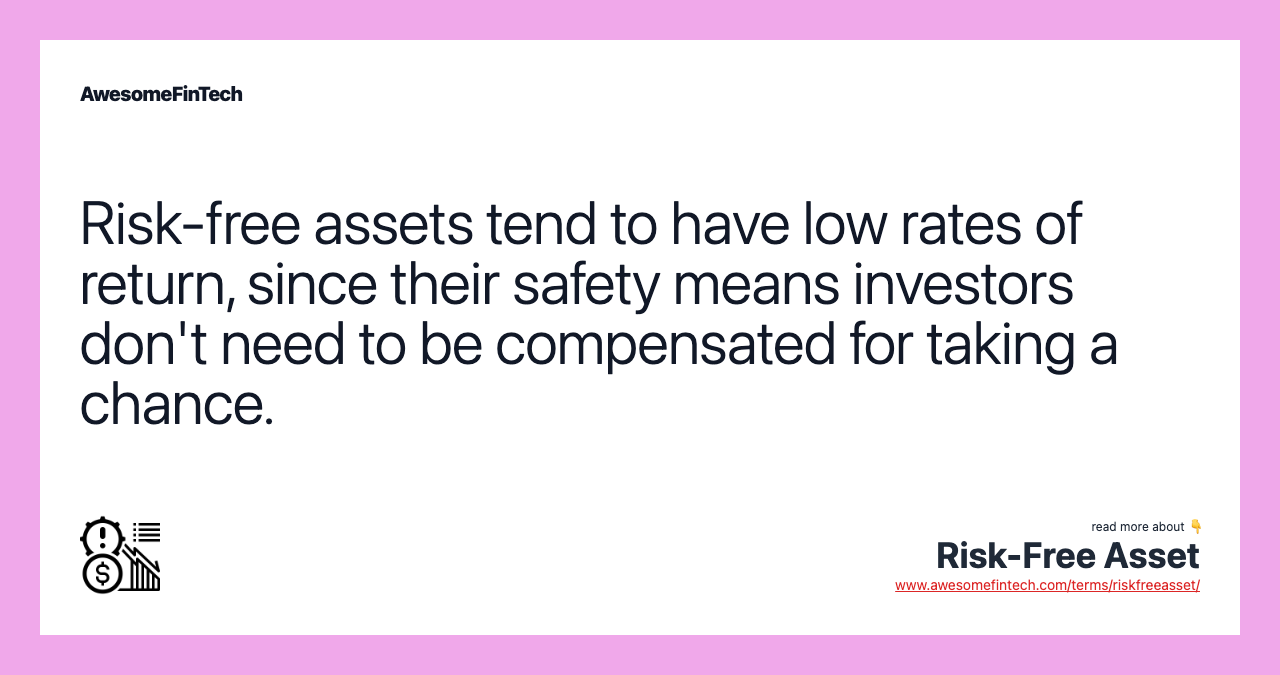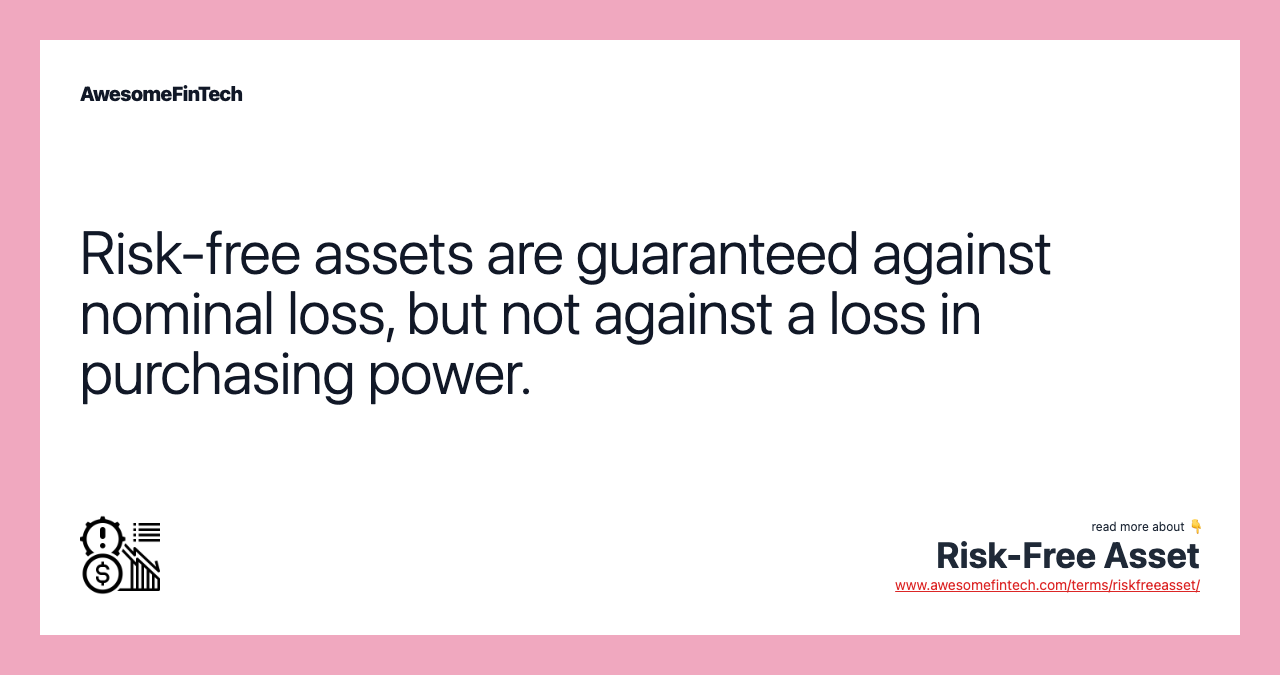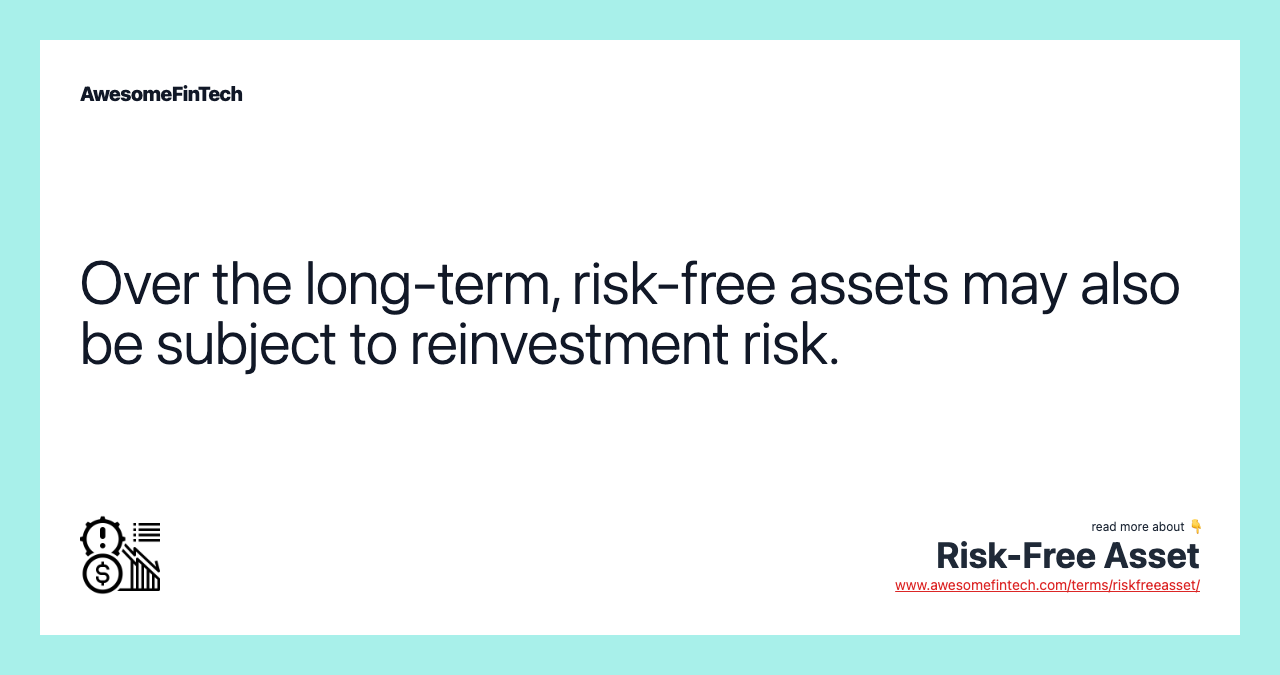Risk-Free Asset
A risk-free asset is one that has a certain future return — and virtually no possibility of loss. A risk-free asset is one that has a certain future return — and virtually no possibility they will drop in value or become worthless altogether. Risk-free assets tend to have low rates of return, since their safety means investors don't need to be compensated for taking a chance. Risk-free assets are guaranteed against nominal loss, but not against a loss in purchasing power. Over the long-term, risk-free assets may also be subject to reinvestment risk. When an investor takes on an investment, there is an anticipated return rate expected depending on the duration the asset is held. Investors that purchase a security with some measure of risk higher than that of a risk-free asset (like a U.S. Treasury bill) will naturally demand a higher level of return, because of the greater chance they're taking. In other words, the return on a risk-free asset is added to a risk premium to measure the total expected return on an investment. The risk-free rate represents the interest on an investor's money that would be expected from a risk-free asset when invested over a specified period of time.

What Is a Risk-Free Asset?
A risk-free asset is one that has a certain future return — and virtually no possibility of loss. Debt obligations issued by the U.S. Department of the Treasury (bonds, notes, and especially Treasury bills) are considered to be risk-free because the "full faith and credit" of the U.S. government backs them. Because they are so safe, the return on risk-free assets is very close to the current interest rate.
Many academics say that, when it comes to investing, nothing can be 100% guaranteed — and so there's no such thing as a risk-free asset. Technically, this may be correct: All financial assets carry some degree of danger — the risk they will drop in value or become worthless altogether. However, the level of risk is so small that, for the average investor, it is appropriate to consider U.S. Treasurys or any government debt issued by a from stable Western nation to be risk-free.




Understanding a Risk-Free Asset
When an investor takes on an investment, there is an anticipated return rate expected depending on the duration the asset is held. The risk is demonstrated by the fact that the actual return and the anticipated return may be very different. Since market fluctuations can be hard to predict, the unknown aspect of the future return is considered to be the risk. Generally, an increased level of risk indicates a higher chance of large fluctuations, which can translate to significant gains or losses depending on the ultimate outcome.
Risk-free investments are considered to be reasonably certain to gain at the level predicted. Since this gain is essentially known, the rate of return is often much lower to reflect the lower amount of risk. The expected return and actual return are likely to be about the same.
While the return on a risk-free asset is known, this does not guarantee a profit in regards to purchasing power. Depending on the length of time until maturity, inflation can cause the asset to lose purchasing power even if the dollar value has risen as predicted.
Risk-Free Assets and Returns
Risk-free return is the theoretical return attributed to an investment that provides a guaranteed return with zero risk. The risk-free rate represents the interest on an investor's money that would be expected from a risk-free asset when invested over a specified period of time. For example, investors commonly use the interest rate on a three-month U.S. T-bill as a proxy for the short-term risk-free rate.
The risk-free return is the rate against which other returns are measured. Investors that purchase a security with some measure of risk higher than that of a risk-free asset (like a U.S. Treasury bill) will naturally demand a higher level of return, because of the greater chance they're taking. The difference between the return earned and the risk-free return represents the risk premium on the security. In other words, the return on a risk-free asset is added to a risk premium to measure the total expected return on an investment.
Reinvestment Risk
While they're not risky in the sense of being likely to default, even risk-free assets can have an Achilles' heel. And that's known as reinvestment risk.
For a long-term investment to continue to be risk-free, any reinvestment necessary must also be risk-free. And often, the exact rate of return may not be predictable from the beginning for the entire duration of the investment.
For example, say a person invests in six-month Treasury bills twice a year, replacing one batch as it matures with another one. The risk of achieving each specified returned rate for the six months covering a particular Treasury bill's growth is essentially nil. However, interest rates may change between each instance of reinvestment. So the rate of return on the second Treasury bill that was purchased as part of the six-month reinvestment process may not be equal to the rate on the first Treasury bill purchased; the third bill may not equal the second's, and so on. In that regard, there is some risk over the long term. Each individual T-bill's return is guaranteed, but the rate of return over a decade (or however long the investor pursues this strategy) is not.
Related terms:
Actual Return
Actual return refers to the de facto gain or loss an investor receives or experiences on an investment or portfolio. read more
Asset
An asset is a resource with economic value that an individual or corporation owns or controls with the expectation that it will provide a future benefit. read more
Default Risk
Default risk is the event in which companies or individuals will be unable to make the required payments on their debt obligations. read more
Expected Return
The expected return is the amount of profit or loss an investor can anticipate receiving on an investment over time. read more
Financial Asset
A financial asset is a non-physical, liquid asset that represents—and derives its value from—a claim of ownership of an entity or contractual rights to future payments. Stocks, bonds, cash, and bank deposits are examples of financial assets. read more
Immunization
Immunization is a strategy that matches the duration of assets and liabilities, minimizing the impact of interest rates on the net worth. read more
Inflation
Inflation is a decrease in the purchasing power of money, reflected in a general increase in the prices of goods and services in an economy. read more
Interest Rate , Formula, & Calculation
The interest rate is the amount lenders charge borrowers and is a percentage of the principal. It is also the amount earned from deposit accounts. read more
Opportunity Cost
Opportunity cost is the potential loss owed to a missed opportunity, often because option A is chosen over B, where the possible benefit from B is foregone in favor of A. read more